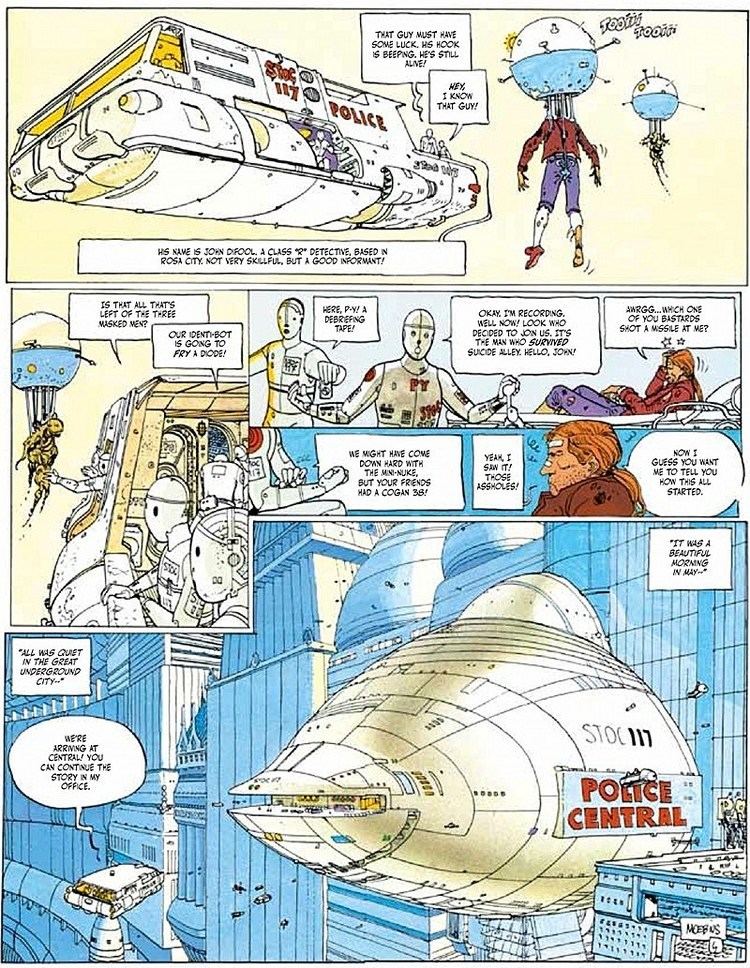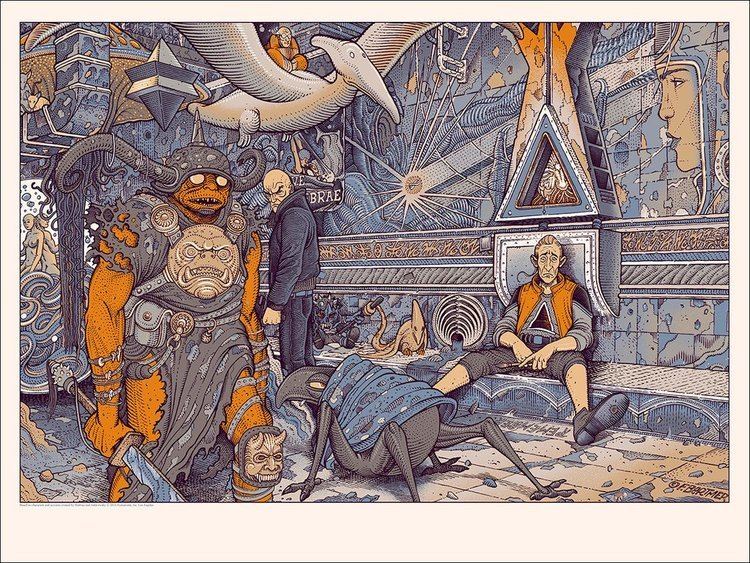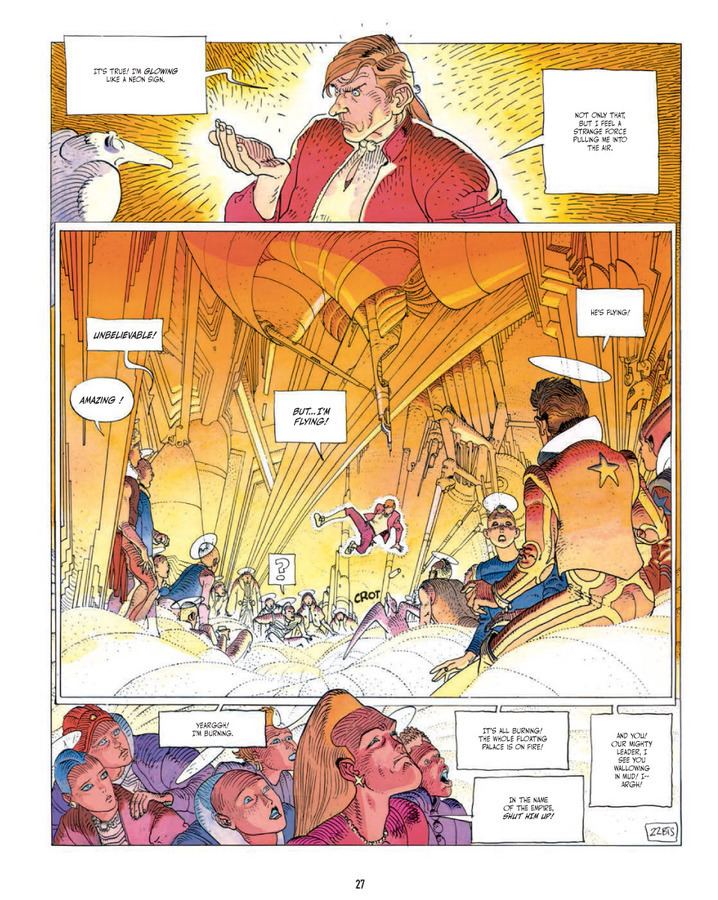Date 1981-2014 Language French Main characters John DiFool | Date of publication 1981–1988 Writer Alejandro Jodorowsky | |
 | ||
Followed by Before the Incal (1988–1995); After the Incal (2000); Final Incal (2008–2014) Books The Incal Tome 1: The Black, The Incal Tome 2: The Lumi, The Incal, What Is Above, The Dreaming Galaxy Similar Metabarons, Arzach, Blueberry, The Technopriests, Blacksad | ||
Ep71 jodorowsky s dune review the jodoverse comics the incal metaberons
The Incal (French: L'Incal) is a French graphic novel series written by Alejandro Jodorowsky and originally illustrated by Jean Giraud. The Incal, with first pages originally released as Une aventure de John Difool ("A John Difool Adventure") in Métal hurlant and published by Les Humanoïdes Associés, introduced Jodorowsky's "Jodoverse" (or "Metabarons Universe"), a fictional universe in which his science fiction comics take place. It is an epic space opera blending fantastical intergalactic voyage, science, technology, political intrigues, conspiracies, messianism, mysticism, poetry, debauchery and satire. The Incal includes and expands the concepts and artwork from the abandoned film project Dune directed by Jodorowksy and designed by Giraud from the early 1970s.
Contents
- Ep71 jodorowsky s dune review the jodoverse comics the incal metaberons
- Graphic novel review the incal
- The Incal
- Before the Incal
- Final Incal
- Main characters
- Analysis
- Style
- Publication history
- After the Incal
- Reception and legacy
- Legal issues
- Adaptations
- References

Originally published in installments between 1981 and 1988, and followed by Before the Incal (1988–1995, with Zoran Janjetov), After the Incal (2000, with Jean Giraud), and Final Incal (2008–2014, with José Ladrönn) has been described as a contender for "the best comic book" in the medium's history. From it spin-off related series Metabarons, The Technopriests, and Mégalex.

Graphic novel review the incal
The Incal

The story is placed in the dystopian capital city of an insignificant planet in a human-dominated galactic empire, wherein the Bergs, aliens who resemble featherless birds and reside in a neighboring galaxy, make up another power block. It starts in media res with DiFool tossed off by a masked group from the Suicide Alley down to the great acid lake, luckily saved by a police cruiser. During the questioning he denied that he received the Light Incal, a crystal of enormous and infinite powers (it guides and protects those who believe in it), from a dying Berg. The Incal is then sought by many factions: the Bergs; the corrupt government of the great pit-city; the rebel group Amok (led by Tanatah); and the Church of Industrial Saints (commonly referred to as the Techno-Technos or the Technopriests): a sinister technocratic cult which worships the Dark Incal. Animah (an allusion to anima), the keeper of the Light Incal, seeks it as well. During the journey DiFool and Deepo are joined by Animah, The Metabaron, Sunmoon, Tanatah (sister of Animah) and Kill Wolfhead, with a task of saving the universe from the forces of the Dark Incal, and the Technopriests manufactured and launched into outer space sun-eating Dark Egg. As the darkness is overcome, DiFool is brought before Orh, the father-like divinity, who told him to he must remember what he witnessed. As DiFool falls away, he finds himself where he was at the beginning, falling down the shaft.
Before the Incal

The story is considerably more straightforward noir tale of boundless urban corruption with the relative absence of spiritualistic elements, which dips deeper into exploring the urban fabric of the world of The Incal. The story follows young DiFool living in demimonde. He soon finds that his prostitute mother devoted herself to growing amorine, a drug that restores the ability to love. His father, Olivier DiFool, breaks the law in wearing a fake halo that is the mark of an aristo. Justice is harsh for such transgressions of class — a legal clause "allows the condemned man to choose between a tablet at the morgue-wall, where he'll sleep away his thirty-year-and-one-day term", or "remodeling", which means having entire memory wiped. His father chooses remodeling. DiFool soon begins to investigate the mystery of disappearance of the children of prostitutes, something he shouldn't find out.
Final Incal

The story from the unfinished After the Incal was rewritten to provide a separate narrative for this volume. The story starts after The Incal climax in which John DiFool encountered a flowing-bearded divine being named Orh, witnessing a universe-shaking event, hurtling towards certain death in the acid lake. DiFool forgets about the cosmic encounter, and recovers his memory as the universe faces a threat of a metallic virus. The Prezident was cloned in metallic body, equipped with both chemical and brutal weapons, but also altered mind - operating under the influence of the "destroyer of all living things", the Bentacodon (equivalent to The Incal's Black Egg). He unleashed destructive organic virus called the Biophage 13-X with the purpose of forcing the population to abandon their natural bodies in favor of robotic ones. The only way to counteract is to reunite John DiFool with his true love, Luz de Garra (from Before the Incal), and the Elohim (a force of goodness) makes four John DiFools from different realities to encounter each other on a quest to find her. It is ridiculed the ego of the allegedly evolved guru DiFool and the super-evolved "angelic" DiFool, and the least enlightened DiFool, the ugliest and most craven, is selected to save the universe. In the end, the cosmic humanity managed to become one collective consciousness, as a true love saves from turning into unfeeling metallic beings.
Main characters

Analysis

The center of the concept is the DiFool's fantastic spiritual journey (or initiation) on a cosmic scale, which he is reluctant to accept and constantly wishes to return to his own ignorant reality of simple hedonistic pleasures. It is an allegory for the sins repeating, the futility of complacency and the necessity for individual transformation. As the story progresses he keeps changing, becoming more heroic, even physically more handsome. In the original six installments it begins and ends by DiFool falling from the bridge, he descends, ascends and later re-descends in "closed" circularity.

The universe is split into two galaxies, a human (with 22,000 planets), and Bergs (featherless birdlike aliens), and the story is placed at four planets in the human galaxy: Ter21, Techno-Gea, Aquaend, and the Golden Planet.
On the planet Ter21 social class is divided on the fortunate (common and aristocrats) who reside at the top, and the others (including the mutants led by Gorgo the Foul who represent the poor living in misery, on the fringes of society, minorities of all kinds) who live down in the pits. At the top, it's a near-panopticonical dystopia with standard TV program (with the same presenter Diavaloo) depicting filmed violence for public consumption, and indoctrination. Seemingly no one works anymore, and all the life is mediated through the TriD (TV), even their dreams. People are addicted to "love drug" amorine, while the president is engaged in repeated body transplants. The masculine role is ridiculed by mass-produced holographic prostitutes. The technopriests represent human most damning, avaricious drives.
John DiFool is based upon The Fool from tarot with his name being a pun upon "John, the Fool". Animah's name is based on the Jungian concept of the anima, the feminine part of every male's psyche, as well in Latin "anima" means "psyche". The series has no taboo, an attitude towards, sex, violence and general social stigmas that may be avoided in more conventional comics. They include Black-and-white dualism or the conflict between good and evil, mystical symbolism, archetypes, metaphysics, tarot and other influences. In the story there's often a conflict between the life or nature and the dead technology (even uniformity and diversity), as "glasses enable you to see, that's technology. But happiness is not that, it's not your glasses. It's what you are able to see. If you have wonderful glasses but don't know how to see what's in front of you, then that technological tool is useless". The series also showcase the religion, economy, politics and warfare, all mixed together.
The Final Incal is kind of call for revolt to organize life in a different way, because as an individual the people are mortal but as humanity itself they are immortal. To learn that others exist, to live together and give, that there is continuity only as part of humanity as a whole. It demonstrates that "love is the ultimate purifier; a force that can cleanse, renew and revitalize".
Style
The series capture worlds with cityscapes, huge spacecrafts and lands populated by technopriests, rubbish-dwelling mutants, doppelgängers, giant jellyfish, chiming forests of gems and jostling, old gurus floating on crystals, underground rat army, flying leeches, "necro-panzers", selfish humanity among others. Some touches are borrowed directly from Dune: the Empress, a "perfect androgyne", or Aquend, a planet composed entirely of water is Arrakis's seeming opposite, and a "mentrek" who betrayed his former master.
Jean Giraud, also known as Moebius, artwork and Yves Chaland colouring from The Incal were well praised. Jodorowsky initially didn't have a script, but recounted and mimed the ideas to Moebius who sketched the scenario, recorded their conversation on tape, and they jointly altered the plot. Jon Evans considered resemblance to the De Stijl school of art inspired by artists like Piet Mondrian and Vilmos Huszár.
Moebius refused to do Before the Incal, thus Jodorowsky found Zoran Janjetov. Although Janjetov had own style, he was influenced by Moebius and imitated him. Finally, Moebius decided to do After the Incal, but beside his illness at the time he had a different style, and Jodorowsky was not satisfied by the overall work. He depicted the nightmare of the tech-world with a more abundant sense of optimism, something peppered with light and hope throughout.
José Ladrönn's rendition of the worlds that Moebius originally designed in the rewritten sequel Final Incal is much darker, grittier, the streets are emptier, less colorful, more muted. He exceled at drawing, but as if he has studied not only Moebius but also the movies that Moebius influenced, directly or indirectly (like Blade Runner).
Publication history
The Incal was published in three volumes by Epic Comics (a division of Marvel Comics) as a part of their Epic Graphic Novels line, in translations by Jean-Marc Lofficier and Randy Lofficier, in 1988. Later between 2001 and 2002 was republished a series of The Incal and Before the Incal in a twelve issue limited series, with the former in two parts Orphan of the City Shaft and John DiFool, Class "R" Detective between 2002 and 2003, while the first in two parts The Epic Conspiracy and The Epic Journey softcover trade format by Humanoids Publishing. The Humanoids Publishing initial version (of both The Incal and Before the Incal) was recolored in a more modern style and had the nudity censored. Jodorowsky did not like the change of the series to seduce young audience.
In December 2010, Humanoids released a limited edition oversized hardcover edition of The Incal, with only 750 copies printed. It was sold out and soon the series was out of print in the United States. In 2011 more hardcovers were released by Humanoids Publishing in the USA and Self Made Hero in the UK. Smaller than the oversized hardcover edition they resemble it in that they restore the original colouring and remove the censorship. In 2012 Humanoids Publishing released 9.4 x 12.6" limited deluxe edition of Before the Incal with a foreword by José Ladrönn, artist on the upcoming Final Incal. Between January 2013 and 2014, they released a sold out 12 x 16" limited coffee table edition of The Incal six volumes.
In 2014 the Humanoids Publishing released 7.9 x 10.8" hardcover trade collection of The Incal, and its sequels After the Incal and Final Incal in one complete collection simply called Final Incal, as a 9.5 x 12.5" deluxe slipcase hardcover, as well limited and numbered edition 12 x 16" coffee table format. In 2015 they released a 7.9 x 10.8" hardcover trade edition, but without After the Incal. In 2014 all the four volumes were digitally released by the Humanoids Publishing.
It was translated from French in more than eleven languages, selling hundreds of thousands of copies.
The Incal
- L'Incal Noir ("The Black Incal") (1981)
- L'Incal Lumière ("The Luminous Incal") (1982)
- Ce qui est en bas ("What Lies Beneath") (1984)
- Ce qui est en haut ("What is Above") (1985)
- La cinquième essence – Galaxie qui Songe ("The Fifth Essence – The Dreaming Galaxy") (1988)
- La cinquième essence – La planète Difool ("The Fifth Essence – Planet DiFool") (1988)
Before the Incal
- Adieu le père ("Farewell, father") (1988)
- Détective privé de "Classe R ("Class "R" Detective") (1990)
- Croot! (1991)
- Anarchopsychotiques ("Psycho Anarchist") (1992)
- Ouisky, SPV et homéoputes ("Vhisky, SPV and Homeo-Whores") (1993)
- Suicide Allée ("Suicide Alley") (1995)
After the Incal
- Le nouveau rêve ("The New Dream") (2000)
Final Incal
- Les Quatre John Difool ("The Four John DiFools") (2008)
- Louz de Garra ("Luz De Garra") (2011)
- Gorgo Le Sale ("Gorgo the Foul") (2014)
Reception and legacy
Rolling Stone magazine in "The 50 Best Non-Superhero Graphic Novels" list placed the original volume as #30, calling it "one of the great comics team-ups". Patrick Hess from Nothing But Comics placed it as fourth out of seventy best comics list, as "there are very few comics ever created in the history of the medium that are this imaginative, this thoughtful, this heartfelt or this good".
Mark Millar called it "quite simply one of the most perfect comics ever conceived and probably the most beautiful piece of graphic literature ever drawn".
Anthony Paletta from Los Angeles Review of Books considered that "The Incal isn’t only a parade of thrilling grotesqueries: it also has a spiritual core that ... reflects Jodorowsky’s abiding idiosyncratic Buddhism", while "Moebius’s work is simply some of the most beautiful not merely in his catalog, but in the comics world at large". He noted that the "echoes of The Incal can also be found in the work of Hayao Miyazaki, Katsuhiro Otomo’s Akira, the decaying futurity of Ridley Scott’s Blade Runner, The Matrix, and even depictions of Coruscant in the Star Wars prequel films.
Daniel Kalder from The Comics Journal noted that the drawing by Moebius in After the Incal was of lesser ability, he considered "Moebius was and always will be The Man but he was not the man for this story: Ladrönn was. And so while After the Incal is certainly an intriguing footnote, a glimpse of a path not taken, Final Incal is the real deal".
Hugh Armitage from Digital Spy noted that Moebius's After the Incal "delivers some typically breathtaking scenery, but his characters take on a cartoonish, Sergio Aragonés-like style that is both atypical for the artist and at odds with the dark story. [Valérie] Beltran's colours leave the images looking flat and uninteresting", and praised the Ladrönn's artwork in Final Incal.
Legal issues
Moebius and Jodorowsky sued Luc Besson, director of The Fifth Element (1997), claiming that the film borrowed graphic and story elements from The Incal, but they lost their case. In an interview given to Chilean newspaper The Clinic, Jodorowsky claimed that neither he nor Moebius actually sued Besson, but that the editor of the comic book was the one who did so. He further claimed that he lost the case because Moebius "betrayed them" by working directly with Besson on the production of the film. In a 2002 interview with the Danish comic book magazine Strip!, Jodorowsky considered it an honour that somebody stole his ideas.
Adaptations
In the 1980s the Canadian animation director Pascal Blais created a short trailer for The Incal (i.e. Dark Incal), but the movie was never made. In 2011 and 2016, his studio made updated versions of the original trailer.
In 2013, in an interview by France Inter it was announced that Nicolas Winding Refn is working as a director on a live-action movie adaptation of The Incal, however in 2016 it was dismissed.
